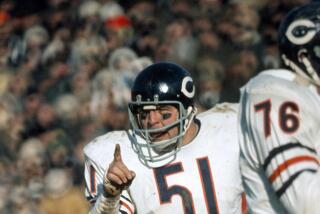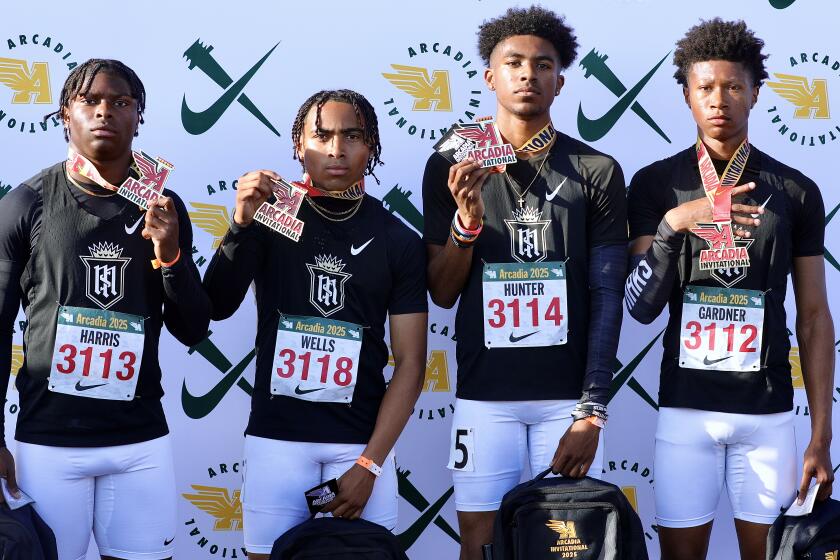They’re Still Winners . . . Still Play Hurt
- Share via
It was a passive morning at Passing Fancy, the flat expanse of farmland where John Unitas, wife Sandra and their three children live in comfort and a laid-back, kick-off-your-shoes kind of rural leisure.
Their impeccable white-fenced sanctuary is located in the Long Green Valley, affording a grand vista of the Maryland countryside, away from the public glare but, at the same time, not so private that it’s a self-imposed isolation.
Sons Joey and Chad are away at college; daughter Paige is a student at St.Paul’s School For Girls. And the most famous player in the history of the Baltimore Colts and the consummate quarterback, the best the NFL has ever known, is recovering from surgery to an arm that was once so lethal it shot holes in otherwise airtight defenses, created an effusion of points and caused scoreboards to short-circuit.
Unitas was a talent unto himself. Physically strong, mentally alert, quietly defiant in the face of all challenges and beyond intimidation. Respected by the men on the other side of the scrimmage line, as well as revered by teammates. A guard named Art Spinney, who played to his left, referred to him as the “meal ticket.” To halfback Lenny Moore he was simply “Johnny U.”
At the moment, Unitas is a Colt in harness, wearing a protective case around his right arm, from wrist to mid-biceps, and facing at least three months of therapy with the hope that some percentage of normal strength will eventually return to a limb that progressively went limp.
The complex surgery, performed by Dr. Andrew Eglseder at the University of Maryland Hospital Medical Systems, took five hours and involved repairing and relocating ligaments, removing bone fragments and moving the ulnar nerve to its proper location.
The injury that triggered the belated trauma was suffered in 1968 in the final game of the preseason, when Unitas leaned away to avoid an all-out rush from the Dallas Cowboys and, in trying to get under the pressure to deliver a pass with a sidearm delivery, had the flexor and pronator muscles torn from their track by the intensity of the hit.
It was the season in which he would come back to throw only 32 passes, and his replacement, Earl Morrall, became the NFL’s Most Valuable Player. And there was the journey to Super Bowl III--a long afternoon for the Colts as they lost to the New York Jets, 16-7, in one of the most momentous upsets in NFL history.
Now, almost three decades later, the residual results of the damage caused his right arm to lose strength. Near paralysis.
“I couldn’t hold a cup of coffee or pick up a pen to sign my name,” he explained. “I wasn’t able to grip a golf club, carry a suitcase or even lift a knife or fork.”
Now, after the surgical phase, all he can do is proceed with rehabilitation, under the direction of his longtime friend and physical therapist, Bill Neill, at Kernan Hospital, and await improvement.
He has two artificial knees from earlier operations, which he says “work fine,” and a plastic replacement for a middle-finger knuckle that he first shattered when he hit a player’s helmet while following through on a pass. An artificial joint had been inserted, but while splitting wood for the fireplace the pressure of swinging the ax caused the replacement knuckle to break.
Then, don’t forget the quadruple bypass heart surgery in 1993 that became a life-or-death situation when he was in the hospital for what was expected to be a slightly more than routine knee operation.
The pertinent question for Unitas was first asked by his son, John Jr., who is in charge of Unitas Management Corp.
“Young Johnny wanted to know if I thought all these problems were worth playing 18 years of pro football,” said his father. “My reaction is, I wonder where I would be without playing football. I guess I’d be teaching school. That’s what I went to the University of Louisville for, to get a degree in teaching.
“That would have been a useful way to make a living. With my arm that went bad, the X-rays never showed the extent of the injury or the aftermath of the cortisone shots I took at the time.
“Dr. Eglseder mentioned, after what he found, that he didn’t know how I was able to play the last four or five seasons. The ligaments just reattached themselves where they weren’t supposed to be, and I guess I made the best of the situation. Maybe that was nature taking over. A lot of NFL players are having problems in later life. Nothing new about that.”
More to Read
Go beyond the scoreboard
Get the latest on L.A.'s teams in the daily Sports Report newsletter.
You may occasionally receive promotional content from the Los Angeles Times.









